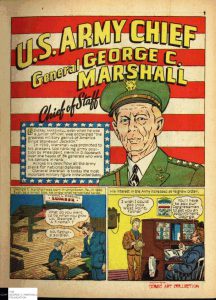Despite having no congressional resolutions or presidential proclamations, September 25th is considered National Comic Book Day. Comic books have been enjoyed as far back as the late 18th century. These early comics featured Japanese Toba-e style prints that were bound in an accordion-style book. Comic books have remained popular because they tell an ongoing story, provide humor and offer suspense.
During World War II, a time filled with death and devastation, American comic book publishers thought it was crucial for morale to provide an alternative to the traditional superhero-type stories. The publishers began to produce comics that focused on accurate biographies of famous historical figures. Often included were stories of ordinary people and animals that performed deeds of heroism and courage. The series It Really Happened epitomizes this ‘ordinary hero’ genre because creator William Wise wanted to inspire children to strive for greatness in their own lives. Picture News also featured factual stories, but it concentrated on educating children about current events through entertainment.
 |
 |
 |
 In his lifetime, George C. Marshall appeared in 5 non-fiction type comic books, all of which have been digitized by the Foundation. He was featured among other great historical figures like John Paul Jones, Lewis and Clark and Jackie Robinson. Many aspects of his childhood, education at the Virginia Military Institute and Army career are included in these issues.
In his lifetime, George C. Marshall appeared in 5 non-fiction type comic books, all of which have been digitized by the Foundation. He was featured among other great historical figures like John Paul Jones, Lewis and Clark and Jackie Robinson. Many aspects of his childhood, education at the Virginia Military Institute and Army career are included in these issues.
Even after his death, the legacy of Marshall’s character continued to influence traditional superhero comic works. In 1983 in The Infinity Syndrome! (Volume 1 Issue 25 of DC Comics’ All Star Squadron), Marshall briefs members of the Justice Society of America, that includes Batman, Wonder Woman and Green Lantern, at the War Department about Ultra-Humanite’s plan to attack various U.S. defense plants across the United States.
